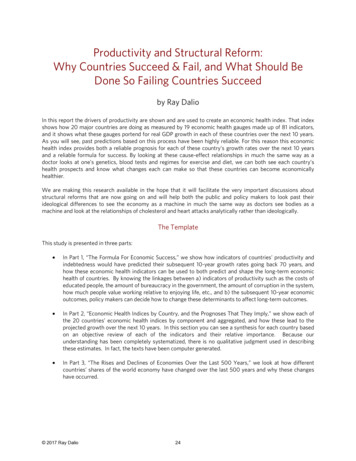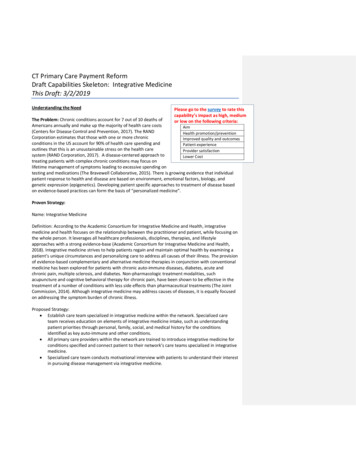
Transcription
Productivity and Structural Reform:Why Countries Succeed & Fail, and What Should BeDone So Failing Countries Succeedby Ray DalioIn this report the drivers of productivity are shown and are used to create an economic health index. That indexshows how 20 major countries are doing as measured by 19 economic health gauges made up of 81 indicators,and it shows what these gauges portend for real GDP growth in each of these countries over the next 10 years.As you will see, past predictions based on this process have been highly reliable. For this reason this economichealth index provides both a reliable prognosis for each of these country’s growth rates over the next 10 yearsand a reliable formula for success. By looking at these cause-effect relationships in much the same way as adoctor looks at one’s genetics, blood tests and regimes for exercise and diet, we can both see each country’shealth prospects and know what changes each can make so that these countries can become economicallyhealthier.We are making this research available in the hope that it will facilitate the very important discussions aboutstructural reforms that are now going on and will help both the public and policy makers to look past theirideological differences to see the economy as a machine in much the same way as doctors see bodies as amachine and look at the relationships of cholesterol and heart attacks analytically rather than ideologically.The TemplateThis study is presented in three parts: In Part 1, “The Formula For Economic Success,” we show how indicators of countries’ productivity andindebtedness would have predicted their subsequent 10-year growth rates going back 70 years, andhow these economic health indicators can be used to both predict and shape the long-term economichealth of countries. By knowing the linkages between a) indicators of productivity such as the costs ofeducated people, the amount of bureaucracy in the government, the amount of corruption in the system,how much people value working relative to enjoying life, etc., and b) the subsequent 10-year economicoutcomes, policy makers can decide how to change these determinants to affect long-term outcomes. In Part 2, “Economic Health Indices by Country, and the Prognoses That They Imply,” we show each ofthe 20 countries’ economic health indices by component and aggregated, and how these lead to theprojected growth over the next 10 years. In this section you can see a synthesis for each country basedon an objective review of each of the indicators and their relative importance. Because ourunderstanding has been completely systematized, there is no qualitative judgment used in describingthese estimates. In fact, the texts have been computer generated. In Part 3, “The Rises and Declines of Economies Over the Last 500 Years,” we look at how differentcountries’ shares of the world economy have changed over the last 500 years and why these changeshave occurred. 2017 Ray Dalio24
Part 1: The Formula for Economic SuccessWhat determines which countries prosper and which countries don’t? What determines different countries’future growth rates? For our investment purposes we look at relationships between causes and effects that wehope will be useful to others in answering these questions.While many people have provided opinions about why countries succeed and fail economically, they have notshown linkages between causes and effects. As a result, their opinions can be misleading. Often, even commonlyagreed-upon indicators of what is good for an economy have not been properly analyzed and correlated withsubsequent results. For example, everyone knows that having a more educated population is better than havinga less educated population, so naturally we hear that improving education is important to improvingproductivity. However, indicators of the cost-effectiveness of education are lacking and correlations of thefactors with subsequent growth don’t exist, at least to my knowledge. That is dangerous. For example, if policymakers simply educate people without considering the costs and paybacks of that education, they will wasteresources and make their economies less productive even though we will become more educated people. Tomake matters worse, the views of those who influence policies typically reflect their ideological inclinations (e.g.,being politically left or right), which divides people. For this reason, I believe that objective good indicators thatare correlated with subsequent results are needed so that the facts speak for themselves and help people reachagreement about what should be done. That is what I believe I provide here. The economic health indicators thatI will show would have predicted the subsequent 10-year real growth of the 20 countries shown over the last 70years within 2% of the realized growth about 85% of the time and within 1% two-thirds of the time, with theaverage miss of less than 1%.While I believe that the body of evidence I will show you is compelling, I certainly don’t claim to have all theanswers or expect people to blindly follow what is presented here without poking at it. On the contrary, I amputting these cause-effect relationships on the table to help foster the debate to bring about progress. I hopethat people of divergent views will explore and debate how the economic machine works by looking at both thelogic and the evidence presented here, then see what it portends for the future, and then explore what can bedone to make the future better. Having said that, we are confident enough in these estimates to bet on theiraccuracy, which we do in our investments.The Determinants of Economic Health Are Timeless and UniversalAs with human bodies, I believe that the economies of different countries have worked in essentially the sameways for as far back as you can see so that the most important cause-effect relationships are timeless anduniversal. In this section I review these cause-effect relationships and look at many countries in differenttimeframes to show how they worked. I will lay these out for you to consider. I don’t believe that it’s goodenough to just show the correlations between changes in these factors and their outcomes. I believe that it’snecessary to be so clear on the fundamental cause-effect relationships that it seems obvious that they must beso; otherwise you can’t be confident that a relationship is timeless and that you aren’t missing something. I willfirst present the concepts and then take you into the indicators to show how they worked in the past and whatthey portend for the future.What Are the Keys to Success?I Will Start with a Top-Down Perspective: As with health, many factors (reflected in many statistics) producegood and bad outcomes. You can approach them by looking down on the forest or building up from the trees. Inpresenting them I wrestled with whether to start at the top and work our way down through all the pieces or startwith all the pieces and work ourselves up to the big picture. I chose to approach this from the top down as that’sthe perspective that I’m more comfortable with. I prefer to simplify and then flesh out the picture. Receiving 2017 Ray Dalio25
information presented this way will require you to be patient with the sweeping generalizations I make until I getdown to the particulars that make them up, which will show both the norms and the exceptions.Productivity Influences on Growth Are Intertwined with Debt Influences: While my objective is to look atproductivity in this section, in doing so I wanted to tie that into looking at the drivers of growth over the next 10years, which is affected by debt as well as the drivers of productivity. In other words, productivity influences ongrowth and debt influences on growth are unavoidably entangled. As explained in “How the Economic MachineWorks,” while productivity growth is ultimately what matters for long-term prosperity, and the effects of debtcycles cancel out over time, the swings around that productivity long-term trend arising from debt cycles cancelout over such long amounts of time (upwards of 100 years because of long-term debt cycles) that it is impossibleto look at growth periods without debt cycles playing a role in driving the outcomes. Of course, when onelengthens the observed timeframe, the shorter-term volatility that is due to debt swings diminishes inimportance. We chose to look at rolling 10-year periods of 20 countries which gave us a sample size of 150observations (where we measure every 5 years).The Big Picture: Stepping away from the wiggles of any given day, and looking from the top down, one can seethat the big shifts in economic growth are about two-thirds driven by productivity and one-third driven byindebtedness. “Luck” (e.g., having a lot of resources when the resources are valuable) and “conflict” (especiallywars) are also drivers.ProductivityA country’s production (GDP) will equal its number of workers times the output per worker (productivity). Onecan increase one’s productivity either by working harder or by working smarter. Productivity is driven by howcost-effectively one can produce, so, relative productivity—i.e., competitiveness—will have a big effect onrelative growth. In a global economy those producers who are more competitive will both 1) sell more in theirown country and other countries, and 2) move their production to countries where they can produce more costeffectively. Likewise, investors will follow these opportunities.Competitiveness (i.e., relative productivity levels) is driven by what you get relative to what you pay in onecountry versus another. Countries are just the aggregates of the people and the companies that make them up.As you know with the individuals you hire and from the products you buy, those that offer the most value formoney are the most competitive and do better than those that don't.Specific Indicators: Since people are the largest cost of production, it follows that those countries that offer thebest “value” (i.e., the most productive workers per dollar of cost) will, all else being equal, experience the mostdemand for their people. That is why the per-hour-worked cost differences of educated people (i.e., their incomeafter adjusting for hours worked each year) is one of the best indicators of productivity. Other obvious andimportant factors that influence productivity include cost of uneducated people, levels of bureaucracy, attitudesabout work, raw material costs, lending, and capital market efficiencies—i.e., everything that affects the value ofwhat is produced relative to the cost of making it. In other words, there is a world market for productiveresources that increases the demand, and hence the growth rates, for the countries that are most competitivebecause of “the cost of production arbitrage.” That cost of production arbitrage has been a big driver ofgrowth—in fact overwhelmingly the largest. To reiterate, the magnitude of this competitiveness arbitrage isdriven more by the cost of the workers relative to how hard they work, their education, and investment levels,than by anything else. These variables characterize the value of hiring a worker in a given country and doingbusiness there (i.e., what you pay for what you get).Of course, barriers to the flow of trade and capital (like China’s closed door policies until the early 1980s,geographic isolation, etc.) can stand in the way of people, companies, and countries being allowed to compete.As these barriers break down (e.g., transportation becomes cheaper and quicker, telecommunications reduce 2017 Ray Dalio26
impediments to intellectual competition, etc.) or increase (e.g., trade barriers are put up), the ability to arbitragethe costs of production, and in turn the relative growth rates, is affected.While countries that operate efficiently will grow at faster paces than countries that operate inefficiently, thecountries that will grow the fastest are those that have big inefficiencies that are disposed of. As an example,in the 1970s and 1980s, China had a well-educated, intelligent labor force that could work for cheap, but faced aclosed-door policy. Opening the door unleashed China’s great potential. Looking forward, while the UnitedStates is relatively efficient, it would not grow as fast as Russia (i.e., which has competitively priced educatedpeople with low debt) if Russia could significantly reduce its barriers to productivity (e.g., corruption, lack ofdevelopment of its debt/capital markets, lack of investment, lack of innovation, bad work attitudes, lack ofadequate private property laws, etc.). That is why I am most optimistic about inefficient countries that areundertaking the sort of reforms that are described in this section.Culture is one of the biggest drivers of productivity. It’s intuitive that what a country’s people value and howthey operate together matters for a country’s competitive position. Culture influences the decisions people makeabout factors such as savings rates or how many hours they work each week. Culture can also help explain whya country can appear to have the right ingredients for growth but consistently underperform, or vice versa. Forexample, in Russia, which has a lot of untapped potential, the culture that affects lifestyles (e.g., alcoholism, thelow drive to succeed, etc.) causes it to substantially under-live its potential, while in Singapore, where highincome levels make their labor relatively uncompetitive, their lifestyles and values (e.g., around working, saving,and investing) allow them to realize a higher percentage of their potential. While lots of elements of culture canmatter, the ones that I find matter most are: 1) the extent to which individuals enjoy the rewards and suffer thepenalties of their productivity (i.e., the degrees of their self-sufficiency), 2) how much the people value savoringlife versus achieving, 3) the extent to which innovation and commercialism are valued, 4) th
by Ray Dalio In this report the drivers of productivity are shown and are used to create an economic health index. That index shows how 20 major countries are doing as measured by 19 economic health gauges made up of 81 indicators, and it shows what these gauges portend for real GDP growth in each of these countries over the next 10 years.File Size: 1MBPage Count: 110




![Financial Services Regulatory Reform (00C) [Read-Only]](/img/2/2018-03-29-davis-polk-financial-services-regulatory-reform-tool-march-2018.jpg)






